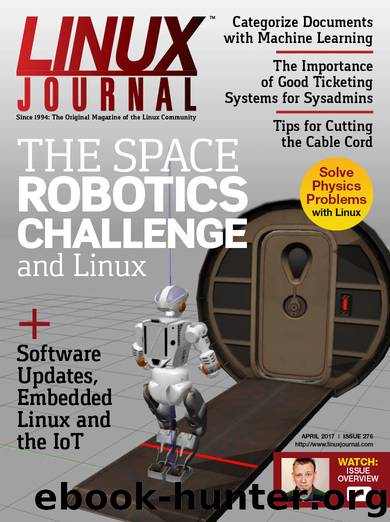Linux Journal April 2017 by Linux Journal

Author:Linux Journal
Language: eng
Format: mobi, epub
Tags: Google Calendar, Documents, ImageMagick, Ticketing, Space, IoT, Elmer, Stringify, Systems, Android, Gazebo, Internet of Things, Classifying, Embedded, Command Line, Updates, Mac2Imgur, ROS, Watermarking, SRC, ElmerGUI, IFTTT, Challenge, Docker, Physics, Software, Text, Image, Robotics, Machine Learning, SysAdmins, NASA, Watermark, Linux, Scheduling
Publisher: Belltown Media
Published: 2017-03-29T07:00:00+00:00
Figure 7. The preamp is as close to the antenna as possible.
Figure 8. The power injector can be a bit away from the actual preamp.
Multiple Antennas?
If you have towers that are in different directions, it’s possible to point two directional antennas and combine the signal to get both. Logically, this makes a ton of sense, especially if you have towers that are impossible to get with a single antenna. Unfortunately, it seldom works in practice. The problem is that along with combining reception, it also combines interference and noise. The end result is usually channels that have a ghosting effect, and instead of getting both towers, you end up with neither.
If you want to try using multiple antennas, be sure to get the smallest directional antennas you can use and still get a signal. The idea is to tune in only the tower you’re pointing at, so the interference is limited. Still, it’s a long shot and seldom works. There are additional steps you can do like installing channel filters so only specific frequencies come through to the antenna combiner, but it becomes complicated and expensive very quickly. I’ve never had luck with multiple antennas, but some people do.
Seven Televisions?
There are seven televisions in my house: one in each bedroom, one in my office, one in the upstairs family room and one in the living room. I have Ethernet or Wi-Fi to each TV, but only one has COAX. I have no desire to run COAX cables and enough preamps to get television signal to each room. So for me, there has to be another step to cutting the cord—namely, network distribution of television channels. Thankfully, a few options work really well.
The Tablo DVR (http://a.co/7bmdB5q) is a device that has built-in tuners for watching and recording OTA (over the air) television (Figure 9). It requires an external hard drive and a subscription for TV guide information. Some apps make watching television easy on devices like the Roku, but paying for a subscription feels a bit like cable television fees. The system is reported to work well, however, so if you’re looking for a DVR option, it’s worth looking at. I want my local stations only for watching the news and the Thanksgiving Day Parade, so DVR isn’t really high on my priority list, so I chose to install an HDHomeRun CONNECT device.
Download
This site does not store any files on its server. We only index and link to content provided by other sites. Please contact the content providers to delete copyright contents if any and email us, we'll remove relevant links or contents immediately.
Test-Driven iOS Development with Swift 4 by Dominik Hauser(10391)
Filmora Efficient Editing by Alexander Zacharias(6711)
The Infinite Retina by Robert Scoble Irena Cronin(6215)
Learn Wireshark - Fundamentals of Wireshark. by Lisa Bock(4482)
Linux Device Driver Development Cookbook by Rodolfo Giometti(4047)
Edit Like a Pro with iMovie by Regit(3916)
Linux Administration Best Practices by Scott Alan Miller(2961)
Linux Command Line and Shell Scripting Techniques by Vedran Dakic & Jasmin Redzepagic(2909)
Mastering PowerShell Scripting - Fourth Edition by Chris Dent(2873)
Creative Projects for Rust Programmers by Carlo Milanesi(2711)
MCSA Windows Server 2016 Study Guide: Exam 70-740 by William Panek(2601)
Docker on Windows by Stoneman Elton(2392)
Kali Linux - An Ethical Hacker's Cookbook: End-to-end penetration testing solutions by Sharma Himanshu(2372)
Hands-On AWS Penetration Testing with Kali Linux by Karl Gilbert(2214)
Hands-On Linux for Architects by Denis Salamanca(2149)
Computers For Seniors For Dummies by Nancy C. Muir(2124)
Programming in C (4th Edition) (Developer's Library) by Stephen G. Kochan(2121)
The Old New Thing by Raymond Chen(2076)
Linux Kernel Debugging by Kaiwan N Billimoria(1834)
